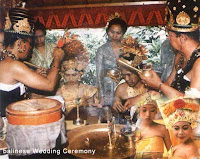In the 19th century, when Westerners were hoisting their countries' flags on foreign lands, they were also unconsciously integrating their own cultures with the arts of the subjugated people.
A fresh look was given to art pieces that were previously classed as "primitive" or "decadent". Viewed with a fresh perspective, native works of art were now given attention by aficionados.
Chinese brush paintings, Indian statues, Japanese prints and African masks became objets d'art that were highly appreciated. Colonialism thus simultaneously exploited and opened the world, creting a modern global culture. Western influence on Balinese paintings did not stop at the stage of appreciation and appropriation. In the 1920's and 30's, a group of western artistis came to stay in Bali, exerting their influence in the production of Balinese paintings.
The two most prominent in the group of expatriates were Walter Spies, a German musician-cum-painter, who later became an authority on Balinese culture; and Rudolf Bonnet, the Dutch portrait painter. These two painters practically started a period of renaissance in Balinese art that was to be called Pita Maha (1935). They distributed paper to the local artists, advised them on how to represent anatomy and depth, and opened up new markets in Europe for Balinese paintings.
However, and contraty to what some Balinese would like us to believe, the art of painting in Bali never received the same attention as bestowed to its theater and dances. Even though many exhibitions were held, Balinese painting was never put on a par with Chinese paiting or even Persian miniatures. It was considered a minor art.
This mis-recognition can be traced to cultural and historical bias: to the westerners of the time, Bali was too multi-facetted-blending "pasific" structures of belief, and Indian faith, Chinese decorative techniques and a Javanese historical background to be ever granted the status of a "great tradition".
Much of Balinese painting was also recent as it lacked the label of a bona fide "ancient culture". But aesthetic expectations and prejudices may also have played a major role: the blunt symbolism of the "primitive arts", the use of flat color surfaces in Javanese prints, and the sover synthetism of Far-Eastern drawing undoubtedly appealed more to Westerners than the complex, overburdened narrative of Balinese painting. It can thus be asserted that the full recognition of Balinese paiting was impeded by the Westerner's inability to accept the validity of the aesthetic principles underlying it.
What are these principles? And did they transform themselves in the course of time?
When one looks at a Balinese painting, the first striking thing is its concept of space, which is totally alien to the Western/modern eyes. A Western-or even a Far-Eastern painting - is always centered around one or several central "subjects", forms or/and color surfaces.
There is a focus, a "descrimination" between the elements of representation. The canvas appears "unequally" occupied, and the onlooker can thus visually "grasp" the theme right away if the work is figurative, or appreciate its composition intuitively if it is abstract. Balinese space in painting strikes out as totally different: The surface of the canvas is "full" to the point that nothing stands out, either thematically or "visually". To Western-ers, this is beyond "apperciation"as they are "blinded" by the accumulation of element overfills the surface.
The original model of this "full space" characteristic is found in Balinese classical painting and in its modern "derivative" of Kamasan. The narrative is told in the lower part of the painting, while its upper part is covered with clouds and godly characters. Such a dense occupation of the canvas mirrors a mystic world whose "invisible" (niskala) elements are as important as the "visible" (sekala) ones. This may well explain the resilience of this notion of "full space".




